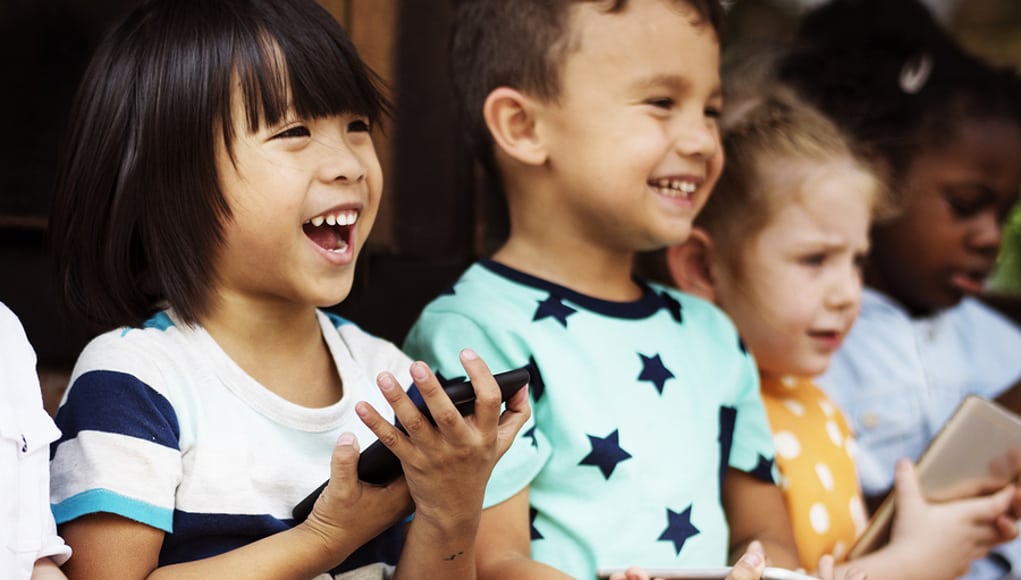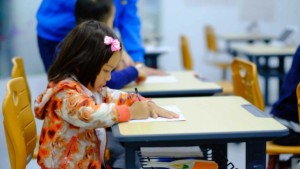Preparing Today’s Students for Success Tomorrow Via Networks

By Gregg Behr
In his recent post, “Network Effects in Education,” Tom Vander Ark compares today’s networks to new life forms: groups of people, empowered by connectivity, that behave “a lot more like a live organism than a hierarchy.”
It’s an apt metaphor. Technology is advancing so rapidly that it’s impacting our very biology: According to neuroscientist Gary Small, research shows that “Modern kids’ brains — brains that have been steeped in digital media since infancy — are actually evolving differently than other brains.”
New life forms, indeed.
As a species and a society, we’re headed toward an era for which we have no reference point — toward a time remarkably unlike our own. From the way networks function to the way our brains develop, everything about the world as we know it stands to be revised, redefined and remade in the coming years. It’s exciting, sure, but it’s also a challenge: How can we possibly prepare today’s learners to thrive in such a future?
Consider our current approach. The vast majority of students attend schools designed during and for the factory era — a time when even the most basic knowledge and skills could lead to stable, lifelong careers on the assembly line. Though most of those jobs have long since disappeared, our 19th-century model largely remains intact.
Tomorrow’s graduates won’t assemble cars; they’ll design the computers that drive them. They’ll be tasked with tackling climate change and global hunger. They’ll be required to think critically, solve complex problems, work collaboratively and communicate effectively. Yet by and large, an American education still consists of easily memorized (and quickly forgotten) facts and figures. Our schools were simply never designed to do what we now need them to do, and the cracks are beginning to show.
Clearly, we need a new model.
Enter Tom’s thesis. “What comes with this new life form,” he writes of modern networks, “is a great opportunity to supercharge the social sector — how we support lifelong learning and provide youth and family supports. We haven’t quite figured out how to do it, but the opportunity set seems to get better every month.”
Perhaps nowhere is that opportunity set more expansive than here in Pittsburgh, where Remake Learning has worked for a decade to supercharge the region’s social sector on behalf of kids.
Comprising more than 250 schools, universities, libraries, startups, nonprofits, museums and others, our network aims to provide children and families with equitable access to relevant, meaningful learning experiences that leverage technology, art, the learning sciences and diverse environments.
We believe that in order to truly prepare kids for tomorrow, we need to equip them not only with deep content knowledge and high-tech tools, but also the skills, creativity and empathy necessary for building a more compassionate, sustainable world.
It’s an admittedly tall order, one that began with a repeated refrain from educators: I’m not connecting with students the way I used to. Intrigued, my colleagues and I brought teachers and learning scientists together over breakfast, hoping to hash out the problem. Our discussions grew to include gamers, artists, makers and more — anyone who worked for kids or could help shed light on the rift between learners and educators.
We quickly realized that to truly close the gap would take an all-hands effort, as no one sector had all the knowledge or tools. We’d have to consider all of the places where children learn, both within and beyond traditional classroom walls. We’d have to form, in other words, a network — one that could leverage its members’ individual strengths and resources to catalyze new approaches to teaching and learning, convene diverse people and organizations, communicate great stories, and champion best practices. Remake Learning was born.
That was ten years ago. To say that we’ve learned a lot since then would be an understatement. On one hand, we’ve had some incredible success, growing from an informal breakfast group to a network recognized by Forbes, Stanford Social Innovation Review and the World Economic Forum. The partnerships forged among our members have led to valuable innovations and products: the CREATE Lab Satellite Network, the Children’s Innovation Project, and an early childhood communications app called Message From Me, to name a few.
We’ve collectively invested more than $55 million to advance innovative education across greater Pittsburgh, and our joint programmatic and outreach efforts have reached hundreds of thousands of students, educators, and families — most visibly through Remake Learning Days, a multi-day festival billed as the world’s largest open house for teaching and learning.
Most importantly, we’re several steps closer to building a region where all learners feel empowered and loved. On any given day, a student can now access several learning pathways based on his or her interests. A learner interested in coding, for example, can get help from Teens as Teachers at Assemble, a neighborhood afterschool space, or drop in on a workshop at her local library to experiment with robotics.
That, in turn, might lead her to Tech Warriors, an afterschool program at the Neighborhood Learning Alliance. There, kids build robots with the help of high school mentors using kits developed by Carnegie Mellon University’s National Robotics Engineering Center. There’s no other place in America yet doing collectively what our members are doing: remaking learning together, in all the places children learn.
On the other hand, we still have a long way to go, and we’ve made plenty of mistakes along the way. To guide us moving forward, we’ve developed a free, open-source Remake Learning Playbook that we hope will add to the ongoing #NetworkEffect discussion.
We created it for three reasons: to document the techniques and strategies that have helped our network grow and succeed; to share stories and case studies that illustrate our achievements and challenges; and to help readers like you take what we’ve learned and build upon it. As Tom writes, networks add value by getting bigger and bigger. We hope that by sharing the playbook, we’ll expand our network while helping you grow yours.
Here’s are seven things we’ve learned in this journey so far:
1. Build on Your Strengths.
What makes your city or region unique? What aspects of its identity, institutions and history positions your network to impact learners? Here in Pittsburgh, for example, we have a long legacy of making things and reinventing ourselves.
A former steel town, we’re now a hub for robotics, advanced manufacturing and the arts. This gives our network’s efforts to promote maker and STEAM learning plenty of real-world relevance — and plenty of potential partners to support our work.
2. Encourage Cross-Sector Collaboration.
Remake Learning’s members and advocates include everyone from superintendents to artists to inventors and local politicians. That’s why it’s common, now, to see kids flying drones in classrooms, educators teaching alongside gamers and designers, and officials proclaiming the importance of remaking learning.
As Mark Surman, executive director of the Mozilla Foundation, writes in a playbook essay, “If we want to tackle challenges like spread, scale and equity, we need to change the system at some level. One way to tackle systems change like this is with open, collaborative networks: humans connected to each other bringing their own ideas and solving their own part of the problem.”
3. Equip Educators to Innovate.
Remake Learning’s diverse membership provides educators with everything from new technology, innovative professional development, grants to attend conferences and funding to try new ideas. The Labs, for example — creative tech hubs for teens run by the Carnegie Library of Pittsburgh — began as an experiment funded by small grants. Today, its multiple locations help thousands of learners build robots, film documentaries and record music.
4. Meet People Where They Are.
By spreading network events across different host organizations and locations, you can dramatically increase your scale — and your impact. In 2016, our first Remake Learning Days drew nearly 30,000 kids, parents, and educators to some 250 events hosted by our members across southwestern Pennsylvania and West Virginia. This year, we expanded it even further, hosting more than 350 events with an emphasis on bringing them to underserved and geographically diverse communities.
5. Understand Your Network’s Impact.
Set long-term goals for your network and gather evidence of your progress. Measure your effect on both the members of the network and on the learners they serve. And look for Remake Learning’s ten-year impact report this fall!
6. Be Open and Inclusive.
Actively invite people in. Don’t worry about giving away an extra free slice of pizza; you never know who will come together to create the next great idea. Barriers to network involvement should be minimal — in lieu of rigid membership criteria, for example, Remake Learning allows people and organizations to self-identify as members.
And don’t forget about learners themselves. During this year’s Remake Learning Days, we dedicated two full days to amplifying youth voice. It’s a question we’re always asking ourselves: What might we achieve by not only listening to learners, but partnering with them?
7. Be Audacious.
Don’t be afraid to think big. Our country’s predominant education model is failing too many leaners. Remake Learning is proof that a network of caring people can create change — what began as a series of pancake breakfasts is now an internationally recognized movement.
I encourage you to check out our full playbook for a closer look at Remake Learning’s network model, people, and member organizations. Try it out. Adapt it. Challenge it. We’d love to hear your questions and advice — after all, we’re still learning, too.
To paraphrase Tom: We haven’t quite figured this network thing out, but together, we can get there.
For more, see:
- Activating a Network: Relationships, Trust and Being Selfish
- Getting Smart Podcast | Barry Schuler on the Power of Networks
- Network Effects in Education
Gregg Behr is co-chair of Remake Learning and executive director of The Grable Foundation. Follow him on Twitter: @GreggBehr
Stay in-the-know with all things EdTech and innovations in learning by signing up to receive the weekly Smart Update.







0 Comments
Leave a Comment
Your email address will not be published. All fields are required.